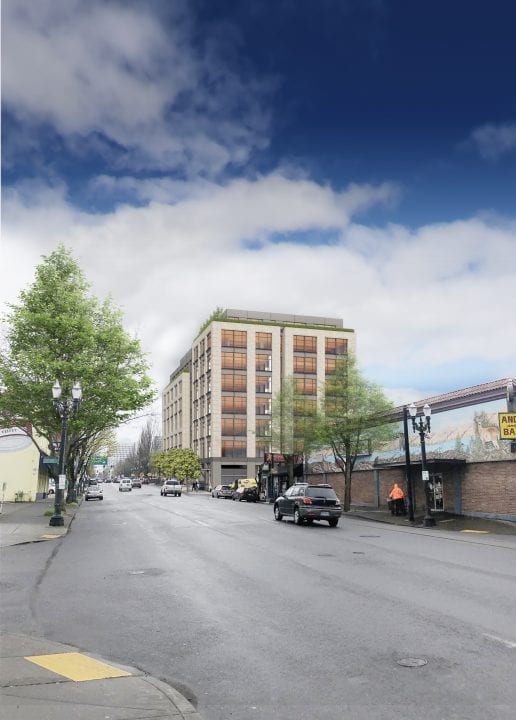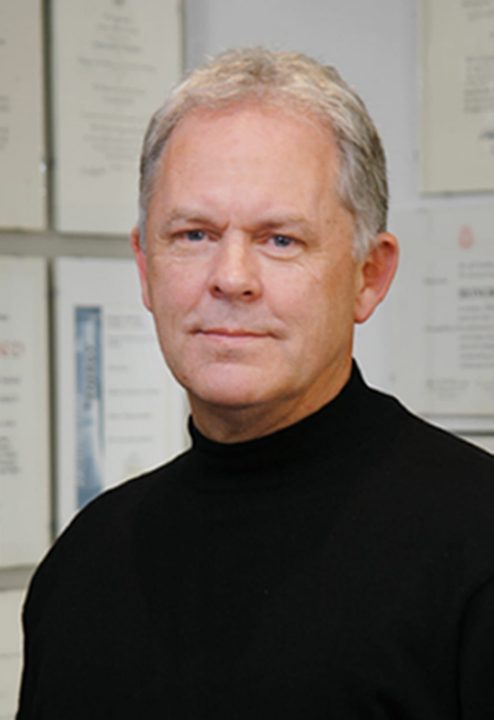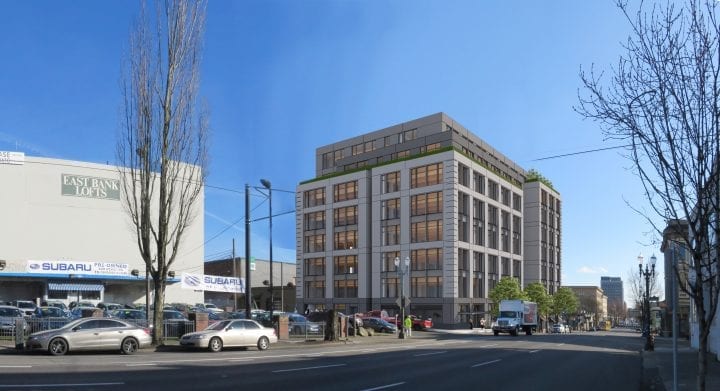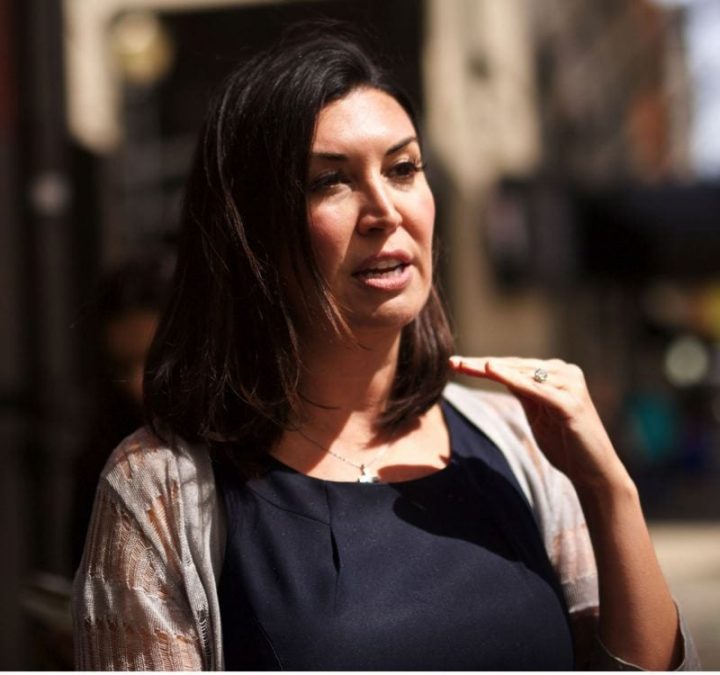Sturgeon Development Partners (SDP) plans to build one of the tallest cross-laminated timber (CLT) buildings in the western United States in an opportunity zone on Southeast Grand Avenue between Ash and Pine Streets.
Called the Flatworks Building, and based at 234-236 S.E. Grand Ave., groundbreaking is set for the end of 2020, with completion in the second quarter of 2022. LMC Construction of Tualatin will be the contractor. The 130,000-square-foot speculative office building will be eight stories tall and shows the confidence that SDP’s president, Vanessa Sturgeon, has in the Portland economy — despite the most significant economic depression since the 1930s (see sidebar).
“We are confident in Portland’s future to attract more businesses and talent to the region,” said Sturgeon, who is the granddaughter of developer Tom Moyer and one of the forces behind Fox Tower and Park Avenue West.
“These have been challenging times for our city, state and country amid the coronavirus, but we will emerge from this stronger. SDP is investing now, because we believe Portland’s commercial real estate industry will continue growing, and that our city’s economic future is bright.”

RENDERING COURTESY: TVA ARCHITECTS – Flatworks on Southeast Grand Ave will be one of the tallest cross-laminated timber buildings in the west, according to Bob Thompson of TVA Architects.
Panels
Flatworks will use Mass Plywood Panels, which are not made in the same crisscross pattern as cross-laminated timber. The building’s design shows it will have an eco-roof and be green building certified, as well as having 42 parking spaces and 45 bike parking spaces. The current tallest CLT building in Portland us Carbon12 on Northeast Fremont Street, which is 85 feet tall.
At the time the design was submitted to the Bureau of Development Services, architect Bob Thompson of TVA Architects commented on the building’s retro design of tall windows and a mix of precast concrete cladding and brick.
“The building will honor and respect the character and the massing — the overall look and feel — of the historic buildings that make up the Grand Avenue Historic District.” The architect will make its design presentation to the city’s Historic Land Use Commission on June 1.
Thompson said, “Oregon and the Pacific Northwest are driven by the timber industry which has allowed us to lead the nation in the continuous evolution of wood-framed buildings,” said Thompson. “Portland’s inner southeast industrial district over the coming decade will emerge as one of the fastest-growing neighborhoods supporting new creative office space, galleries, restaurants and housing. The views back to the city and the West Hills are unparalleled, along with its connection to light rail and our downtown core.”
V-Shaped
Thompson is optimistic about the local economy, saying the fundamentals are good and that as soon as the coronavirus restrictions are lifted, activity will rebound. The recovery will be V-shaped rather than U- or L-shaped.
Flatworks will take a year to design, but some of that work will overlap with construction drawing and groundbreaking, making it three year’s work executed in two. Thompson is sure it will open in early 2022, and there will be demand for office space.
“The economy should be back up and running in a pretty big way. We’re being pretty proactive about making sure that there is available office space back out on the market.”

COURTESY: TVA ARCHITECTS – Architect Bob Thompson thinks there will be a V-shaped recovery and Flatworks will be let when it opens in 2022.
Brown did good
“I do think one of the best things that Oregon’s done, though, is keeping the construction industry open during this period of time. It’s reinforcing the economy better than a lot of states have that it’s done, those that put a halt to construction. We had a number of projects in Washington that went on hold when Governor Inslee rolled construction and manufacturing into a part of their non-essential work. He’s since watched what’s happened in Oregon and how successful Kate Brown’s program has been, and they’ve reopened construction now and manufacturing, which is a real positive for their economy.”
He is optimistic TVA can survive on a mixture of private and publicly funded work. The firm made it through the last recession thanks to private-sector work such as the new headquarters project for Nike over in Shanghai, China, the Phil Knight-funded Matthew Knight Arena at the University of Oregon, and the Park Avenue West tower next to Nordstrom.
“They were all large projects which kept our staff in place, all well-funded projects, too, which really helped us navigate through the Great Recession. Now we’re very busy in the health care area and the multifamily housing.”
He points out that Park Avenue West was just a hole in the ground for five years because “it was privately funded by Mr. Moyer (Vanessa Sturgeon’s grandfather). Then when they went out to the lending markets, that’s when the economy obviously started to decline, in 2008, 2009.”
This downturn is different.
“That recession was all economically driven. There was a lot of long term uncertainty. This (coronavirus slowdown) is a problem independent of the economy. The economy at heart is still strong. Once they find a vaccine, hopefully, the recovery time will be quite a bit shorter.”
Thompson told the Business Tribune that it has been interesting seeing his team of 50 working from home and communicating well virtually.
“It’s going a lot better than what I ever anticipated. I miss the collaboration or the ability to more fluidly connect with people versus like a Zoom meeting.”
TVA has 30 projects on the go. Being project-based means staff has some security two or three years ahead. “Construction is up and running still, which is a blessing. We should be thankful.
Thompson has a wide-angle view of the coronavirus pandemic.
“I’m 65, and back in the late 1960s, there was the Hong Kong flu, and it killed every bit as many people as this one.”
He points out that the Woodstock music festival, which pulled together 400,000 people in a field, was in the summer of 1969 right after the Hong Kong flu, which then spiked in the winter of 1969.
“We didn’t have social media and the cable networks. It was pretty much left up to the medical professions and the scientists, and it wasn’t politicized. It just kind of happened and the economy was never closed. I’m not a proponent for that. It’s just interesting.”

RENDERING COURTESY: TVA ARCHITECTS – Flatworks on Southeast Grand Avenue will be one of the tallest cross-laminated timber buildings in the west. Developer Vanessa Sturgeon thinks the coronavirus Depression recovery will be V-shaped and there will be plenty of demand for office space in Portland in 2022.
Portland confident
Sturgeon told the Business Tribune that opportunity zones caused a stir when they were first announced.
“They caused a lot of interest at the beginning. The COVID crisis has shut down the economy for the moment, but we raised a lot of money for the fund pre-COVID. This project has been in the works for quite some time.”
The investors are still keen.
“We haven’t heard from anyone that’s getting cold feet. The timing is solid because the economy should be recovered by the time we are opening (in 2022).”
Speaking about construction in Portland in general, Sturgeon said, “I think the projects that have already started are going to continue. The question is whether people are going to continue to build speculative office and retail projects.”
The big question is how the market for office and retail space will change. She expects some retail bankruptcies. And the trend for collaborative workspaces — no cubicles, long tables and hot-desking with people wearing headphones — is now dying.
“I think people are thinking about what if this happens again, can we weather the storm effectively? How can we be compliant with social distancing? It costs a lot of money to shut down. Right now, our feeling is that we need to build better stuff. So (that means) creating a workspace that really draws attention and fits with their values. We’re talking about the tallest cross-laminated timber office building in the West.”
Sturgeon says that kind of project will attract companies who value sustainability, the comforting feeling of wood, and the walkability of offices with retail spaces on their ground floor.
“You have to really build something that speaks to people. Standard office space is potentially going to be sitting for quite some time.”

PMG: JONATHAN HOUSE – Developer Vanessa Sturgeon of Sturgeon Development Partners (SDP) plans to build one of the tallest cross-laminated timber (CLT) buildings in the western US in an opportunity zone on Southeast Grand Avenue between Ash and Pine Streets.
She’s a big fan of TVA Architects. “We have always felt that Bob’s architecture stands the test of time.”
Asked what could jeopardize the project in the next two years, she recalled a talk by Ben Bernanke, former Chairman of the Federal Reserve, gave to the Brookings Institution saying that the coronavirus recession is not going to be anywhere near like the Great Depression.
“Frankly, my biggest worry is how it’s going to impact people who were already in a tenuous financial position. So, the homeless or those living on the brink of homelessness. I think that the economy is going to rebound and it’s not going to be a two-year problem. It’s going to be a significant issue for the next several months or year, but Portland has a very strong and stable economy, we don’t overbuild. Our growth is that steady, and I don’t see the virus changing that.”
Asked whether local officials have done a good job so far, she said she didn’t know.
“The state officials are in a very tough spot. They’re prognosticating and doing their best to balance reopening the economy with keeping people safe and healthy. That’s really impossible. So, there’s definitely going to be some (policy) fixes later.”
SDP also has a project at Thurman and Northwest 17th, and she still expects it to open on time in early July. It’s another speculative project, a machine shop being converted into creative office space, and it does not have any tenants yet. “For a really well-done office project, I don’t worry.”
She sees Portland’s growth as unstoppable by any recession.
“I look at Portland as an organic growth area. There are a lot of tech that our opening offshoot offices here, but we also have a lot of organic growth from local companies.”

 By
By